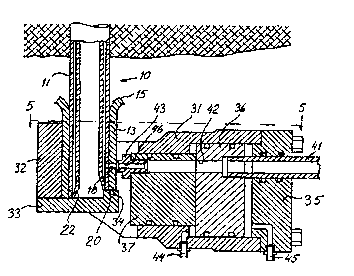Some of the information on this Web page has been provided by external sources. The Government of Canada is not responsible for the accuracy, reliability or currency of the information supplied by external sources. Users wishing to rely upon this information should consult directly with the source of the information. Content provided by external sources is not subject to official languages, privacy and accessibility requirements.
Any discrepancies in the text and image of the Claims and Abstract are due to differing posting times. Text of the Claims and Abstract are posted:
| (12) Patent Application: | (11) CA 2191760 |
|---|---|
| (54) English Title: | TUBEFORMED ROCK BOLT |
| (54) French Title: | BOULON D'ANCRAGE TUBULAIRE |
| Status: | Deemed Abandoned and Beyond the Period of Reinstatement - Pending Response to Notice of Disregarded Communication |
| (51) International Patent Classification (IPC): |
|
|---|---|
| (72) Inventors : |
|
| (73) Owners : |
|
| (71) Applicants : |
|
| (74) Agent: | SMART & BIGGAR LP |
| (74) Associate agent: | |
| (45) Issued: | |
| (86) PCT Filing Date: | 1995-06-01 |
| (87) Open to Public Inspection: | 1995-12-14 |
| Availability of licence: | N/A |
| Dedicated to the Public: | N/A |
| (25) Language of filing: | English |
| Patent Cooperation Treaty (PCT): | Yes |
|---|---|
| (86) PCT Filing Number: | PCT/SE1995/000608 |
| (87) International Publication Number: | SE1995000608 |
| (85) National Entry: | 1996-11-29 |
| (30) Application Priority Data: | ||||||
|---|---|---|---|---|---|---|
|
Tubeformed rock bolt with closed cross section. The rock bolt comprises a tube
(11) provided with a longitudinal depression (12). The tube is at the ends
provided with a first sleeve (14) and a second sleeve (13). The sleeves are
welded to the tube (11) so that a closed room (23) is created. The second
sleeve (13) is provided with a radial groove (20) for giving the rock bolt a
predetermined angular position in a tool used for setting the bolt and a first
hole (18) for injection of cement. The tube (11) is furthermore provided with
a second hole (19) near a first end (21). This hole is a venting hole for the
closed room (23).
Boulon d'ancrage tubulaire de section fermée. Ce boulon d'ancrage comprend un tube (11) pourvu d'une dépression longitudinale (12), et, à ses extrémités, d'un premier (14) et d'un second (13) manchon. Ces manchons sont soudés au tube (11) de façon à créer une chambre fermée (23). Le second manchon (13) est doté d'une rainure radiale (20), permettant au boulon d'ancrage d'adopter une position angulaire prédéterminée dans un outil utilisé pour placer le boulon, ainsi que d'un premier trou (18) destiné à l'injection du ciment. Le tube (11) est en outre doté d'un second trou (19), à proximité d'une première extrémité (21), qui agit comme trou d'évacuation d'air de la chambre fermée (23).
Note: Claims are shown in the official language in which they were submitted.
Note: Descriptions are shown in the official language in which they were submitted.

2024-08-01:As part of the Next Generation Patents (NGP) transition, the Canadian Patents Database (CPD) now contains a more detailed Event History, which replicates the Event Log of our new back-office solution.
Please note that "Inactive:" events refers to events no longer in use in our new back-office solution.
For a clearer understanding of the status of the application/patent presented on this page, the site Disclaimer , as well as the definitions for Patent , Event History , Maintenance Fee and Payment History should be consulted.
| Description | Date |
|---|---|
| Application Not Reinstated by Deadline | 2002-06-03 |
| Time Limit for Reversal Expired | 2002-06-03 |
| Inactive: Status info is complete as of Log entry date | 2002-03-06 |
| Deemed Abandoned - Failure to Respond to Maintenance Fee Notice | 2001-06-01 |
| Letter Sent | 1998-06-08 |
| Reinstatement Requirements Deemed Compliant for All Abandonment Reasons | 1998-06-03 |
| Deemed Abandoned - Failure to Respond to Maintenance Fee Notice | 1998-06-01 |
| Application Published (Open to Public Inspection) | 1995-12-14 |
| Abandonment Date | Reason | Reinstatement Date |
|---|---|---|
| 2001-06-01 | ||
| 1998-06-01 |
The last payment was received on 2000-05-17
Note : If the full payment has not been received on or before the date indicated, a further fee may be required which may be one of the following
Patent fees are adjusted on the 1st of January every year. The amounts above are the current amounts if received by December 31 of the current year.
Please refer to the CIPO
Patent Fees
web page to see all current fee amounts.
| Fee Type | Anniversary Year | Due Date | Paid Date |
|---|---|---|---|
| MF (application, 3rd anniv.) - standard | 03 | 1998-06-01 | 1998-06-03 |
| Reinstatement | 1998-06-03 | ||
| MF (application, 4th anniv.) - standard | 04 | 1999-06-01 | 1999-05-17 |
| MF (application, 5th anniv.) - standard | 05 | 2000-06-01 | 2000-05-17 |
Note: Records showing the ownership history in alphabetical order.
| Current Owners on Record |
|---|
| ATLAS COPCO ROCK DRILLS AB |
| Past Owners on Record |
|---|
| ANITA MANDAL |
| BJORN KAREBY |